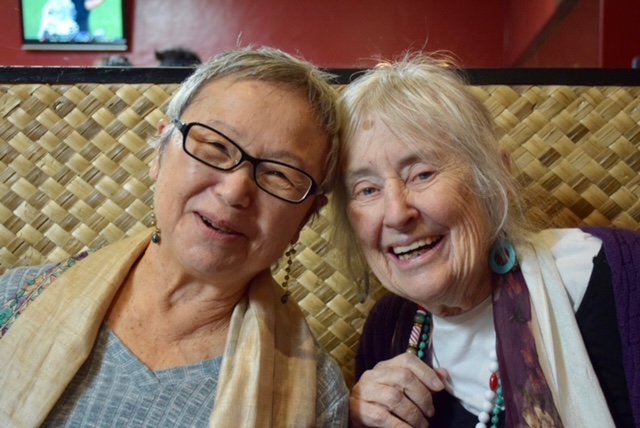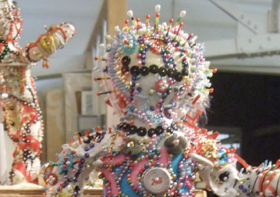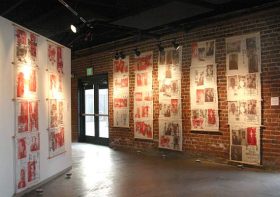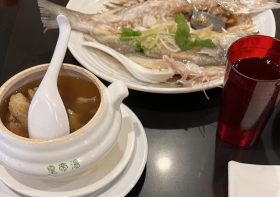“The Divine Miss M” – Moira Roth (1933–2021)

Thank you to artist Reiko Fujii for sharing this selection of photographs of Flo Oy Wong and Moira Roth, Trefethen Professor of Art History at Mills College in Oakland, California from 1985 to 2017, and friends.
In an oral history interview with Moira Roth, conducted by Sue Heinemann for the Archives of American Art, Smithsonian Institution on April 22-24, 2011 in Berkeley, California, Roth spoke of her role in the creation of AAWAA.
I was also involved in the creation of the Asian American Women Artists Association, called AAWAA.
And the circumstances of that was that I had been […–MR] moderating a panel on Pat Ferrero’s Hearts and Hands film, which is about American women quilt makers. And I met Flo Oy Wong and she thought it would be very interesting—because I was also on the Women’s Caucus board—if there could be a collection of slides by Asian American women artists.
And I thought that was a great idea. And so she and Betty Kano and I and a number of other people met in Betty Kano’s house to see the slides they’d got together. And then we met again at a Korean American artist’s studio [… – MR] and no one wanted to go home. It was quite obvious this was not just to collect slides but it was to be an organization. And even though I wasn’t Asian, I was one of the founding members.
This meant that while Carlos Villa’s “Worlds in Collision” was going on, there was this very, very vibrant group of Asian American women artists. And they presented work at Mills and they also got involved with the Art Institute. And at a certain point—and I was literally sitting in the audience of the Art Institute—someone came up while I was scowling because I felt there was so much that had to be done immediately.
And I met Diane Tani, who herself is an artist but also an organizer, and she and I fell into a conversation. The result is that we thought just once, but never again, we would do a little catalogue for Bernice Bing, who was one of the founding members of AAWAA whom I had just met and who I don’t think had ever had a catalogue, even though she was well known. And she was going to have an exhibition at SOMArts [South of Market Cultural Center] in San Francisco.
So Diane and I decided we would do this small catalogue. And we came up at the last minute with the title of our press, which in effect was simply the two of us putting together Xeroxed pages and color photographs and we called it Visibility Press. And at this point, we plunged into a sort of format that we would write a preface, there’d be an interview that we would do or I would do with an artist, and then a chronology.
So we did that and then Flo Oy Wong, who is one of the founding members of AAWAA, was going to have an exhibition at Mills and we decided that we would again do a catalogue. And I asked Lucy Lippard, who’s a close friend of mine, if she would write one of the introductions. And then we did several more of these catalogues and every time we would meet at my house. So we would be up all night working and working and proofreading.
And we would make jokes after that. And then we would do one more. So it was—we did five in all and it was, I think, a wonderful experience. We hoped that other artists would just do their own but they would say, “Would Visibility Press like to publish a catalogue on me.” And then we would say, “Well no, you know, we don’t have a board of directors. You can’t apply. We just decide.”
Oral history interview with Moira Roth, 2011 April 22-24, Archives of American Art, Smithsonian.
1989
Asian American Women Artists Association (AAWAA) was founded in 1989 in San Francisco by Betty Kano, Flo Oy Wong, and Moira Roth to promote the visibility of Asian American women artists and to serve as a vehicle for personal expression with a view of Asian American cultures and history from women’s perspectives.
1992
Roth wrote “Entering Unstable Ground: Chinatown, Oakland/Sunnyvale and Georgetown, Maine,” for Flo’s 1992 solo exhibition, Kaleidoscope: Ink Paintings and Drawings by Flo Oy Wong at the Antonio Prieto Gallery at Mills College, published by Visibility Press. Copied with the permission of Flo Oy Wong.
1996
Next of Kin: The Wong Family | Flo, Nellie and William Wong | Sun May 19 1996. Moira Roth moderates a discussion exploring the social, political and cultural dimensions of family and community in the Wong family’s work in the first of Headland Center for the Arts’s series examining how creativity is passed on and transformed by family members.
2000
Moira Roth’s essay, Flo Oy Wong “made in usa: Angel Island Shhh,” a story in three parts was written for Flo Oy Wong’s 2000 installation on Angel Island, was published on Kearny Street Workshop’s “made in usa” website.
2021
Flo’s poem, For the Divine Miss M, Moira Roth, was published on the Asian American Women’s Artist Association website, written in memory of Moira Roth upon her passing. #memoriesofmoira.











